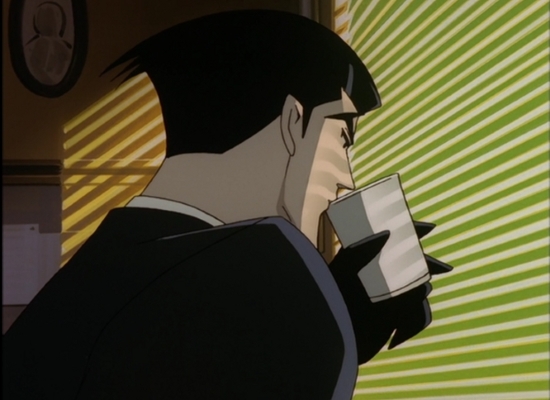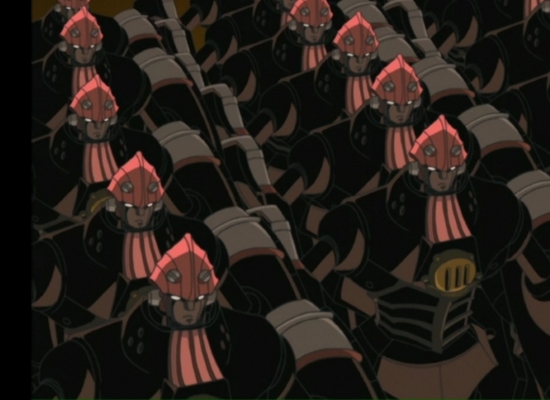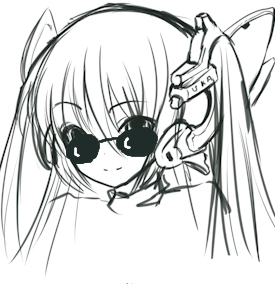
Written by Alexander Smit on 22 Nov 2016
A lot of people really did not care for the second season of Big O. This is entirely fair, mind you: its digipaint holds no candle to the hand-drawn animation of season one (try not to wince when they show fire effects from the first season in the second) and the plot becomes messy to the point of incomprehension.
Yet in that mess there lies a cleverly constructed web of themes and aesthetics that riff on each other to make both the second season and the series as a whole a piece of fiction that is especially concerned with its own nature as such and what that might mean in the larger scheme of things. What that is, is in large part predicated on its two stylistic influences: super robot anime and the film noir genre.

To recap: Big O revolves around Roger Smith. His home is Paradigm City, where everyone lost their memories, together with any sign of life outside its immediate vicinity. As a Negotiator, he solves Paradigm's disputes for hire with the aid of the stoic android, Dorothy, his eye-patched butler, Norman, and the titular Big O, a gargantuan mech from another age.
The punch-thirsty giant embodies the first of the anime's two big influences: the super robot genre. From Mazinger Z to Gurren Lagann, this genre and the supernaturally powerful robots that it stars have been a staple of anime for nearly as long as there has been anime to speak of.
Less familiar to the readers of UK Animemay be Big O's other major influence, film noir. I am presenting these two genres as separate influences that remain clean of each other, but even Big O's most direct inspiration in the super robot genre, Giant Robo, harkened back to the of the early 20th century pulp adventures from which film noir received many of its plots and character archetypes. Film noir, by itself, remains hard to define. Like most genres when subjected to thorough examination, film noir does not have a codified definition, but might best be described as a grouping of tropes that, following a history of films that feature them together, seem to belong together, to create a very specific sort of mood. Film noir films are dark and cynical, filled with death, sex, smooth talkers, and fast women. From film noir Big O gets the femme fatale, that first low angle shot in the first episode of Roger Smith towering above us, the heavy use of shadows that create a mood of dread or mystery.
What brings these two genres of generally opposite outlooks together, is that they revolve around artifacts and artifice.
The artifacts offilm noir are lies and plots that hinder and control the protagonist of the film, if not the whole film world, while super robots are the artifacts central to their own genre, providing man the means to surpass his own limits through technological aid. In both genres there exists a pre-established script to follow. In film noir, that script is either being read to us by the lead as they narrate the events of the film, or unknown to them until it is too late for them to change. Two examples of this come from Sunset Boulevard and Double Indemnity, where the leads have already put the “fatal” in “fatalist” at the start of the film, narrating the events as they lie dead or dying. On the other hand, super robot shows revel in defying presupposed logical outcomes. To quote Kamina from Gurren Lagann: “Kick reason to the curb and do the impossible”. Big O tries to bring together the super robot and film noir genres through their shared theme as well as their aesthetic and in doing so, question the thematic underpinnings of both. Before we get to that though, I am going to need to talk about memories.

Memories are Big O's key plot device. What, exactly, memories are meant to be in the context of the series is obscure, but often they take the form of technological know-how otherwise beyond the ken of Paradigm, from genetic engineering to designs for the gargantuan mech known as a Megadeus (pronounced like an especially eventful trip to the restroom). The result is a city full of androids, unknown architecture, and scientists, as often mad as not. Roger himself is granted the capacity to pilot the titular Big O, along with visions of an apocalyptic battle between other such Megadeuses. Although implied to be memories of the cataclysm that left Paradigm amnesiac those 40 years ago, the ontological status of Paradigm seems far murkier than straightforward chronology would entail. Rather, the last episode of Big O implies that Paradigm exists in a loop and that the memories are not from a past, but from outside reality itself.
For transparency's sake, this reading of Big O's memories is never explicitly confirmed, but there are numerous hints. The loop is implied by things such as Roger imagining various versions of himself and the apocalyptic events that cap the series, along with the implied reboot of reality at the very end. That memories are from outside the reality of Big O takes slightly more explaining, starting with the episode Winter Night Phantom. In Winter Night Phantom, Sgt. Dastun ends up reenacting a tragic shoot-out from a film he could have sworn he saw as a child. A red balloon punctuates scenes where Dastun imagines watching the film, imagines himself in it, and fulfills his fated role. In the second season, the balloon returns at the start and near the end, when Dastun sees a child in his spitting image going to the movies. These balloons act as callbacks to Winter Night Phantom and clue the audience in that its motifs - fated encounters, repeating events, and the bleed between fiction and reality - are central to the series as a whole. Schwarzwald, in a moment of post-mortem triumph, quotes Thomas Hobbes in saying: “Imagination and memory are but one thing which for different considerations have different names”. I say “triumph”, because in that moment he has clued us in to the success of his goal: to seek the truth behind Paradigm city. That truth is that the memories of Paradigm are tantamount to the imaginations of Big O's writers and that Paradigm itself is a fiction. When Gordon Rosewater claims that memories are only found in humans, he is speaking of our humans, the real ones, not the group of animated characters to which he belongs.
Big O allows, and even forces, its characters to become aware of their own artificial nature because being artificial is what Big O is all about. If there is a diegetic (“in world”) reason for Paradigm's repeated existence, it is unknown, but on the meta level there is a very good one: those 40 years and the lack of anything outside them are all that is dramatically relevant for the story of Big O. Every memory, from an author standpoint, exists to drive a plot, providing a mystery to solve, the monster of the week, or a character motivation. The world before forty years ago didn't exist, because that is as far back as the world informs our characters and our understanding of Paradigm. There are many fantasy stories where world-building exists for its own sake, but in general, the rule is to only write enough to support the story you're telling. The Big O distinguishes itself by drawing attention to its lack of non-essential history, its artifice. Characters, aware of their lack of personal history or at least that of Paradigm, find motivation for their actions from that lack. Some of the elderly of Paradigm used their blank slates to start new lives for themselves, others kept searching for their lost pasts.

Author: Alexander Smit
posted by Ross Liversidge on 11 Apr 2025
posted by Ross Liversidge on 08 Apr 2025
posted by Ross Liversidge on 26 Mar 2025
posted by on 21 Mar 2025
posted by Ross Liversidge on 21 Mar 2025
posted by on 10 Mar 2025
posted by Ross Liversidge on 04 Mar 2025